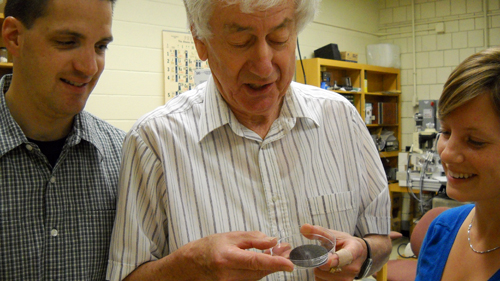
Sorry, too busy. That was Prof. Iain Campbell’s response when a German scientist called in 2004 to ask whether the Guelph physicist might help out with Mars science. Rudi Rieder wanted Campbell’s help to analyze data from two robotic rovers landing on the red planet that year.
For decades, the U of G researcher had applied radiation physics to various Earth-bound projects. He figured he didn’t really need a new project, let alone one from another planet.
Campbell changed his mind a few days later when Rieder showed up in person at his office door. He’s glad he did.
Today most of his research involves refining the physics underlying analysis of data from those earlier rovers and from Curiosity — the rover that landed on Mars in 2012 — and developing new approaches to using those data. Referring to the proton accelerator in his MacNaughton Building lab, he says, “The accelerator is going to be very busy, principally devoted to that work.”
For his varied career contributions to the field of radiation physics – on Earth and off — he received the JARI Medal this year from the Journal of Applied Radiation and Isotopes. The medal has been awarded 12 times since 1980; Campbell is the second Canadian recipient.
This summer also brought him a more customary award marking a different career milestone. A new five-year, $250,000 grant from the Natural Sciences and Engineering Research Council (NSERC) will help carry his lab through to 2019. One year before that, Campbell will mark an unbroken 50 years’ worth of NSERC funding for his Guelph studies of applied and fundamental radiation physics.
Campbell uses that accelerator and a method called PIXE – proton-induced X-ray emission – to look at chemical elements in soil and rock, mining ores and minerals, atmospheric aerosols, biological samples for medical applications and high-tech metal alloys.
PIXE was introduced in Sweden in the early 1970s. Besides furthering the method in his lab, Campbell – along with colleague John Maxwell — developed an analytical software package called GUPIX for determining concentrations of elements in samples. GUPIX is now used by scientists in dozens of countries.
Those applications extend beyond physical and biological sciences to the arts. Ten years ago, for instance, Campbell led a training school at the Louvre in Paris, where researchers trace chemical elements to help establish provenance of artworks from pottery and weaponry to jewelry and paintings.
That’s also when he started working with scientists at Germany’s Max Planck Institute to help interpret information from devices aboard the Mars rovers. X-ray spectrometers on the rovers’ robotic arms look for chemical elements in Martian soil and rock.
Campbell says that information provides clues about whether water existed on Mars. Earlier rover instruments found the first in situ evidence of water bound beneath the Martian surface.
Referring to Curiosity – officially called the Mars Science Laboratory — Campbell says, “The goals of the mission are already accomplished: to find a habitable environment. We have found geochemical and geological traces of a river bed and a lake — indeed a freshwater lake — which could have supported microbial life.”
Those rover devices were designed by an international team of scientists led by Campbell’s colleague, physics professor Ralf Gellert. That global team has helped guide the rover mission and interpret information from Mars, directed by Gellert and other U of G researchers working in a specially built control centre in the MacNaughton Building.
In a 2013 Portico story, Campbell described this project as “the biggest single research venture in the University of Guelph’s history.”
Campbell became a lecturer at the University of Guelph in 1968 after finishing his PhD studies at the University of Glasgow.
Back then, the big space news was the planned Apollo moon shot of 1969. “I was interested in the moon landing from the beginning. I followed everything I could read about it.”
Down in his basement lab, he continues using that proton microprobe to help predict and interpret data from the Mars rover instruments.
Campbell will use his most recent NSERC grant to help recalibrate the rover spectrometer for more accurate measurements of Mars rocks and to help compare rocks on Earth and Mars.
The new five-year grant is worth a total of $250,000 – rather more than his first-ever allotment from the agency 50 years ago, worth about $6,000 a year for two or three years.
By the time he works through the new funding in 2019, Campbell will be 78. “I’m going to get a sweatshirt that says ‘perishable’ on it,” he quips.
Now University professor emeritus, he received the Queen’s Golden Jubilee Medal in 2003 and the University’s Medal of Merit in 2010. He was dean of the College of Physical and Engineering Science from 1987 to 1995, and served as provost and vice-president (academic) from 1995 to 2000.